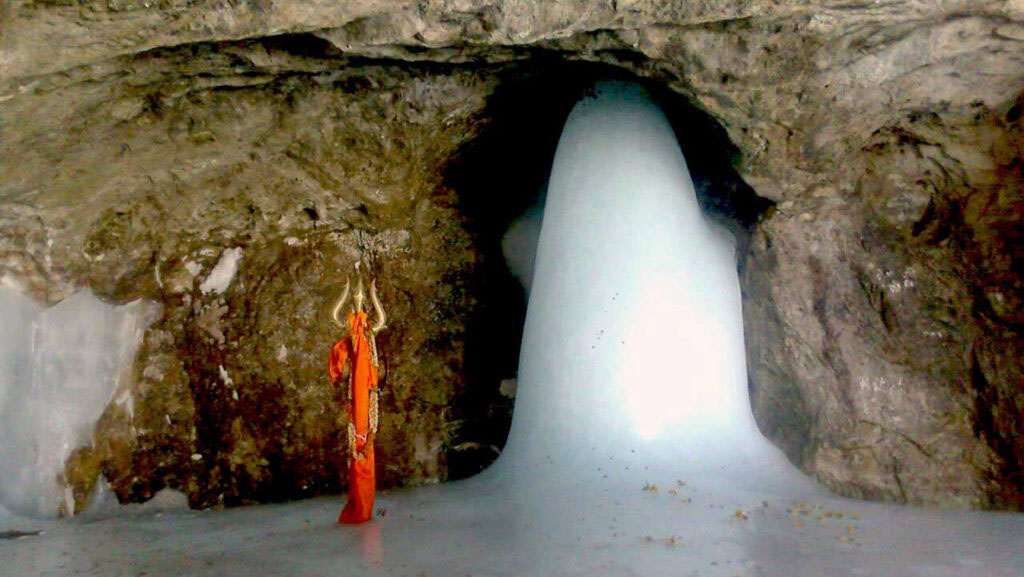
Amarnath shrine, situated at an elevation of 13,000 feet, finally got a motorable road after BRO successfully widened the road from Dumail to Amarnath cave via Baltal base camp in Ganderbal district of central Kashmir drawing bouquets and brickbats. A report by Riyaz Wani
For the first time since its discovery in 1850 by the Muslim shepherd Buta Malik, the Amarnath shrine, situated at an elevation of 13,000 feet, has got a motorable road, a development both welcomed and criticized in equal measure.
The Border Roads Organisation (BRO) has successfully widened the road from Dumail to the Amarnath cave via Baltal base camp in Ganderbal district of central Kashmir. In a statement, the BRO shared a video showcasing the journey of the first set of vehicles reaching the Amarnath cave.
“Project Beacon is involved in restoration and improvement of Amarnath Yatra tracks. Border Roads personnel completed the formidable task and created history with the first set of vehicles reaching the holy cave,” stated the BRO.
Earlier, the Jammu and Kashmir government’s Public Works Department (PWD) and the Pahalgam Development Authority (PDA) were responsible for maintaining the tracks leading to the Baltal and Pahalgam shrines, respectively. However, in September last year, the maintenance and upgradation responsibilities for the Amarnath Yatra tracks were handed over to the BRO.
The BRO celebrated the accomplishment in a video titled ‘Our Men Our Mission – We will either find a way or make one,’ shared by the organization on social media platform X (formerly Twitter).
The 2-minute and 27-second video showcases drone footage capturing a mini-truck accompanied by a dumper navigating the newly constructed road on the slopes of the Himalayan mountains. The video is of the construction work from the Chandanwari side in Lidder Valley, which serves as another of the two gateways to the sacred cave shrine.
The footage also features a group of BRO engineers and workers commemorating the achievement with a photo opportunity, set against the backdrop of the shrine’s entrance. The road is expected to ease access to the Amarnath Shrine, contributing to the convenience and safety of the pilgrimage route.
The shrine, which sits at an altitude of over 13000 feet, houses an ice stalagmite that is believed to be an incarnation of Lord Shiva.
While the BJP has welcomed the road saying lakhs of people have faith in Baba Amarnath, other parties and even several Kashmiri Pandits have slammed the move, terming it detrimental for the Valley’s environment.
Mohit Bhan, a Kashmiri Pandit and PDP spokesperson posted on X: “This is not history, it’s the biggest crime one can commit to Hinduism and its faith in nature. Hinduism is all about immersing in spiritual mother nature, that’s why our pilgrimages are in the lap of the Himalayas.”
Kashmiri Pandit activist Satish Mahaldar said that the government is “refusing to learn the lessons” from the recent climate disasters in India.
“Kedarnath was a real example where encroachment of natural ecosystems triggered nature’s fury and a humanitarian disaster,” Mahaldar said. “We saw how villages after villages sank. Sadly, the government seems intent on bringing these disasters to Kashmir.”
But according to the BJP leader Altaf Thakur, the construction of “the concrete road to the holy cave shrine followed proper Environmental Impact Assessment, and no trees were cut during the entire process.”
The road to Amarnath cave has a political dimension also: In 2008, over 100 people had died in three month long protest after the then state government led by Ghulam Nabi Azad transferred some forest land to Shri Amarnath Ji Shrine Board. The protest was led by separatist groups. In the fifteen years since then, Kashmir has changed beyond recognition, more so after the revocation of J&K’s special constitutional status under Article 370 in August 2019. This status barred outsiders from buying land in Kashmir and would have made construction of this road impossible.













